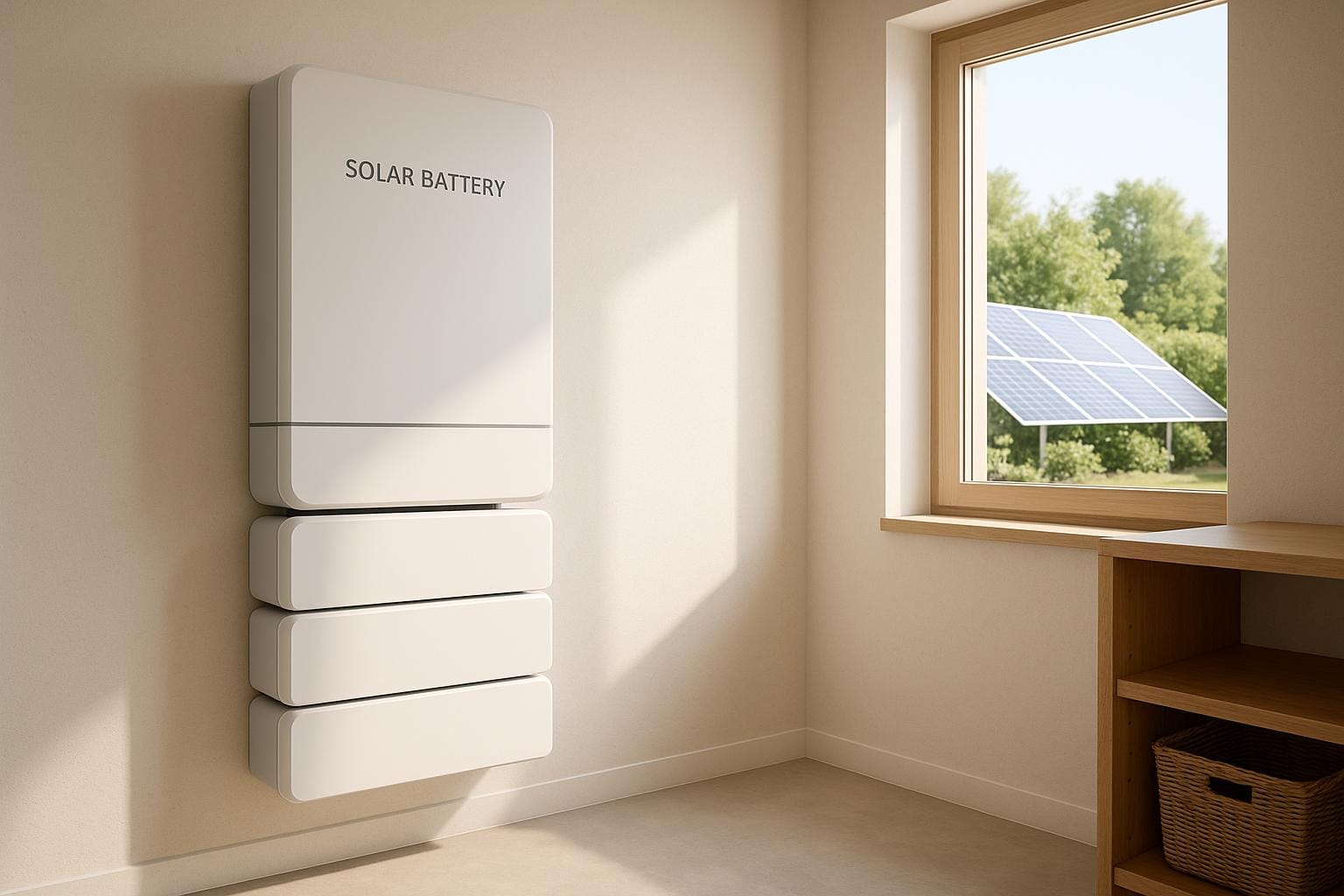Ultimate Guide to Solar Battery Storage
Explore the benefits, types, costs, and maintenance of solar battery storage systems to enhance energy independence and efficiency.

Solar battery storage lets you save the energy your solar panels produce for later use. Instead of sending extra power back to the grid, you store it for use at night or during outages.
Key Benefits
- Lower Energy Costs: Use stored energy during peak rates to save on bills.
- Backup Power: Stay powered during outages.
- Energy Independence: Reduce reliance on utility companies.
Battery Types
- Lithium Iron Phosphate (LFP): Safer, longer-lasting, eco-friendlier.
- Nickel Manganese Cobalt (NMC): Higher energy density but shorter lifespan.
Costs and Incentives
- Price: $10,000–$18,000 (including installation).
- Incentives: 30% federal tax credit and state-specific rebates.
Installation Tips
- Hire certified professionals.
- Choose between DC-coupled (more efficient) or AC-coupled (better for retrofits) setups.
Maintenance
- Keep batteries at 59°F–86°F.
- Use apps to monitor performance.
- Schedule annual professional inspections.
Solar battery systems can last 10–15 years and are a great way to save on energy costs while staying prepared for outages.
Battery Types and Features
Battery Technology Options
Solar storage systems rely on two primary types of lithium-ion batteries: Lithium Iron Phosphate (LFP/LiFePO₄) and Nickel Manganese Cobalt (NMC). Each offers distinct advantages for home energy storage.
| Feature | LFP Batteries | NMC Batteries |
|---|---|---|
| Safety | High – very stable | Medium – some thermal risk |
| Life | Long cycle life | Moderate cycle life |
| Eco Impact | Lower – uses fewer toxic materials | Higher – involves rare metals |
| Energy Density | Moderate | High |
A great example of this progression in battery technology is the Tesla Powerwall series. The Powerwall 2 uses NMC chemistry, while the newer Powerwall 3 transitions to LFP. This shift prioritizes safety and longevity over maximizing energy density.
Battery Size and Output
On average, U.S. households consume 6–10 kWh of electricity daily (excluding heating). A battery with a capacity of 10–15 kWh is generally sufficient to cover most needs.
Here’s what typical battery systems offer:
- Storage capacity: 1–16 kWh per unit
- Power output: 5–12.5 kW
- Expandable options: Stackable units for higher capacity
For instance, the SunPower SunVault can be configured to provide between 13 kWh and 39 kWh when multiple units are combined. On the other hand, the Savant Power Storage 20 delivers a continuous power output of 12.5 kW, making it a strong choice for running multiple high-demand appliances at the same time.
Core Battery Specifications
When comparing solar batteries, three critical specifications help determine their overall performance and value:
| Specification | Optimal Range | Impact |
|---|---|---|
| Depth of Discharge | 90%+ | Provides more usable capacity |
| Round-trip Efficiency | 90%+ | Ensures better energy conservation during charge-discharge cycles |
| Warranty Coverage | 10+ years | Protects your investment over the long term |
Top manufacturers now offer comprehensive warranties to back their products. For example, the SunPower SunVault stands out with its unlimited cycle warranty, while most premium batteries guarantee at least 10 years of operation or around 6,000–10,000 cycles, whichever comes first.
An additional advantage of LFP batteries is their ability to maintain efficiency across a broader temperature range compared to NMC. Up next, we’ll explore how to incorporate these battery features into your solar setup for maximum performance.
Setup and Performance
Pre-Installation Steps
Installing solar batteries starts with thorough planning. A detailed site evaluation should consider:
- Available space in a climate-controlled area
- Structural integrity of mounting surfaces
- Compatibility with the existing electrical system
- Compliance with local building codes and permits
To ensure a smooth process, hire contractors certified by NABCEP and trained by the battery manufacturer, particularly for advanced systems like the Tesla Powerwall or SunPower SunVault. Also, check that your installer has proper insurance and a solid track record of completed projects.
Once the site is ready, the next step is connecting the batteries to your solar panels.
Panel Integration
There are two main ways to connect batteries to solar panels:
| Connection Type | Efficiency Benefit | Best Application | Key Benefits |
|---|---|---|---|
| DC-Coupled | 2-5% higher | New installations | Fewer energy conversion steps for direct power flow |
| AC-Coupled | Baseline | Retrofit projects | Flexible design and easier to integrate |
Hybrid inverters have revolutionized solar setups by combining solar and battery management in one device. These systems optimize energy distribution by considering real-time power use, battery charge levels, utility rates, and grid availability for backup power.
Once your panels and batteries are connected, focus on strategies to maximize system efficiency.
System Efficiency Tips
To get the most out of your solar battery system, consider these tips:
-
Smart Energy Management
Use mobile apps or dashboards to track real-time energy data and adjust usage accordingly. -
Maintain Ideal Battery Temperatures
Keep batteries in the recommended range of 59°F-86°F (15°C-30°C) to avoid performance drops and extend their lifespan. -
Optimize Peak Usage
Plan high-energy tasks, like running appliances, during peak solar production hours. A case study in California showed that this strategy reduced reliance on the grid by up to 80%, saving about $1,200 annually.
Regularly updating your system's software and monitoring its performance are essential for long-term efficiency. Keep in mind that most battery systems lose about 2-3% of efficiency each year, making consistent upkeep critical.
Upkeep and Disposal
Regular Maintenance
Taking care of your batteries regularly keeps them running efficiently and helps them last longer. Lithium-ion batteries, including LFP and NMC types, perform better and stay safer with consistent maintenance.
Temperature Management
Store batteries in areas where the temperature stays between 59°F and 86°F (15°C–30°C). For outdoor setups, use insulated and ventilated enclosures to prevent performance issues. While LFP batteries can withstand higher temperatures better than other types, keeping them in optimal conditions is still key to extending their lifespan.
Monitoring and Inspection
Here’s a quick guide to routine maintenance tasks:
| Maintenance Task | Frequency | Key Actions |
|---|---|---|
| System Monitoring | Daily/Weekly | Use a smartphone app to check charge levels and performance metrics. |
| Visual Inspection | Quarterly | Look for physical damage, corrosion, or unusual swelling. |
| Professional Check | Annually | Have a certified technician inspect the system. |
| Software Updates | As Released | Install updates for the battery management system as they become available. |
To get the most out of your battery, aim to keep its charge level between 20% and 80%.
Warning Signs
If you notice any of the following, reach out to a professional right away:
- A noticeable drop in capacity beyond the typical 2–3% annual degradation
- Excessive heat during operation
- Error codes or warning lights
- Inconsistent performance or frequent shutdowns
End-of-Life Options
When maintenance no longer keeps your battery working well, it’s time to think about disposal. Most solar batteries last 10–15 years before they need to be replaced.
Recycling Process
Recycling can recover up to 95% of a battery’s materials. Here’s how the process works:
-
Initial Processing
Certified facilities safely discharge any leftover energy and break down the battery pack into its components. -
Material Recovery
Valuable materials are extracted using methods like mechanical crushing, chemical processing for metals, and refinement for reuse. -
Environmental Considerations
Compared to NMC batteries, LFP batteries are easier to recycle because they don’t rely on cobalt or nickel. However, recycling methods for newer battery types are still improving.
Proper Disposal Steps
- Reach out to your battery manufacturer or installer to learn about available recycling programs.
- Never throw batteries in regular trash.
- Use certified recycling facilities for safe disposal.
- Keep records of the disposal process for compliance and future reference.
Transporting batteries for recycling must follow Department of Transportation regulations for hazardous materials. Always work with certified professionals to handle disposal safely and in line with legal requirements.
Costs and Support
Price and Returns
The cost of solar battery storage varies based on its capacity and features. High-end systems typically range between $10,000 and $18,000, including installation. For those on a tighter budget, smaller capacity systems can start at around $5,000.
Breakdown of Total Costs
| Component | Typical Cost Range | Notes |
|---|---|---|
| Battery Unit | $5,000–$12,000 | Depends on capacity and features |
| Installation | $2,000–$4,800 | Accounts for 20–40% of the base price |
| Electrical Upgrades | $500–$2,500 | Necessary in some cases |
| Permits | $200–$400 | Costs vary by location |
The return on investment (ROI) for these systems generally falls between 7 and 12 years, influenced by factors like electricity rates, battery efficiency, usage patterns, available incentives, and the frequency of power outages. In areas with high electricity costs or frequent outages, ROI may improve to around 5–6 years. Most lithium-ion batteries are designed to last 10–15 years, with warranties typically covering at least 10 years. Incentives and financing options can further enhance the financial benefits.
Available Programs
Government incentives can significantly lower the net cost of solar battery systems. The federal Investment Tax Credit (ITC) offers a 30% tax credit on installation costs through 2032. Notably, this credit now applies to standalone battery systems, not just those paired with solar panels.
State and Utility Incentives
Several states provide additional programs to make battery storage more affordable:
- California: The SGIP program offers tiered rebates based on battery capacity.
- Massachusetts: The SMART Program includes incentives for solar-plus-storage systems.
- New York: The NY-Sun Program provides per-kWh incentives for battery installations.
- Hawaii: The Battery Bonus Program offers upfront rebates and monthly credits.
Many utility companies also run demand response programs, allowing homeowners to earn $200–$500 annually by permitting grid access to their stored energy during peak demand periods.
Financing Options
Flexible financing can make solar battery storage more accessible. For example, a 10 kWh system priced at $12,000, financed over 10 years at a 6.5% interest rate, would result in approximately $4,200 in added interest.
| Financing Type | Benefits | Considerations |
|---|---|---|
| Cash Purchase | Maximum long-term savings; ownership | Requires a large upfront payment |
| Solar Loan | Low upfront cost; tax credit eligible | Interest rates typically range 5–8% |
| Lease/PPA | Zero down payment; includes maintenance | Lower overall savings |
| HELOC | Lower interest rates; potential tax benefits | Uses your home as collateral |
When considering financing, it’s also worth looking into insurance coverage. Most homeowners' insurance policies will cover properly installed battery systems, though premiums may increase by $50–$200 annually. On the flip side, some insurers offer discounts for homes equipped with battery backups, recognizing their ability to reduce losses during outages.
Conclusion
Summary Points
The world of solar battery storage has seen remarkable progress, with lithium-ion technology leading the charge. Among the options, LFP (lithium iron phosphate) batteries stand out for their improved safety and longer lifespan, while NMC (nickel manganese cobalt) batteries are chosen for their higher energy density.
When considering a solar battery investment, here are some key factors to keep in mind:
| Factor | Current Status | Impact |
|---|---|---|
| Technology | LFP is the preferred choice for homes | Safer and more durable |
| Cost Range | $8,000–$15,000 for 10–13 kWh systems | Depends on capacity and features |
| Federal Support | 30% ITC available until 2032 | Significant savings upfront |
| Lifespan | 10–15 years typical | Influences long-term value |
| Maintenance | Minimal for lithium-ion systems | Reduces ongoing costs |
Additionally, advancements like AI-driven energy management and virtual power plant integration are creating opportunities to connect solar batteries with grid services, boosting their value and functionality.
Getting Started
If you're ready to explore solar battery storage, here’s how to begin:
- Evaluate Your Energy Needs: Start by assessing your household's energy consumption. On average, U.S. homes use 20–30 kWh daily. This will help you determine the right battery capacity for your needs.
- Select the Right Technology: For most residential setups - especially in warmer climates - LFP batteries are a solid choice due to their safety and durability.
- Plan Your Finances: Take advantage of the 30% federal tax credit and look into local incentives. Some utilities also offer demand response programs that can further reduce costs.
- Hire Professionals: Ensure your system is installed by certified experts. Proper installation is key to maximizing performance, and scheduling regular checks will keep your system running smoothly.
Looking ahead, solar battery storage is poised to become even more efficient and accessible. With advancements in energy density, smarter system integration, and recycling processes capable of recovering over 98% of battery materials, the future of solar energy is brighter than ever. By taking these steps, you're well on your way to harnessing clean and sustainable energy for years to come.
The Ultimate Guide to Solar Batteries | With Chris Sparkes
FAQs
What’s the difference between Lithium Iron Phosphate (LFP) and Nickel Manganese Cobalt (NMC) batteries, and which one is better for home solar systems?
When it comes to solar energy storage, Lithium Iron Phosphate (LFP) and Nickel Manganese Cobalt (NMC) batteries are two popular choices, each offering distinct benefits.
LFP batteries stand out for their durability, safety, and ability to maintain thermal stability. They’re designed to handle more charge cycles, which means they last longer over time. These features make them a solid option for home use, especially when reliability is a top priority.
On the other hand, NMC batteries pack a higher energy density. In simple terms, they can store more energy in a smaller, lighter package. This makes them a great fit for situations where space or weight is a concern, although their lifespan may not match that of LFP batteries.
For most residential solar setups, LFP batteries tend to be the go-to choice thanks to their safety, longevity, and ability to handle frequent charging and discharging. That said, the right option for you will depend on factors like your energy requirements, available space, and budget.
How do I choose the right solar battery capacity for my home's energy needs?
To figure out the right solar battery capacity for your home, start by checking your average daily energy usage. You can find this information on your utility bills, which will show how many kilowatt-hours (kWh) you typically use each day. Once you have that number, think about how much of that energy you’d like to store - for example, to power your home at night or during outages.
You’ll also need to factor in the size of your solar panel system, the appliances you want to run on stored energy, and your local weather conditions - like how much sunlight your area gets. For a more tailored solution, reaching out to a solar energy specialist can help you pinpoint the battery size that works best for your situation.
What are the cost savings of solar battery storage, and how do federal tax credits reduce your expenses?
Investing in solar battery storage can be a smart way to cut down on energy costs. By storing the excess energy your solar panels generate, you can use it during peak hours when electricity rates spike. This not only reduces your monthly utility bills but also offers long-term financial advantages by decreasing your reliance on the grid.
On top of that, federal tax credits like the Investment Tax Credit (ITC) can help ease the initial expense. In 2023, the ITC lets you claim 30% of your solar battery system's total cost on your federal taxes. This makes solar storage more accessible for many homeowners. To make the most of these savings, it’s a good idea to consult a tax professional who can guide you on eligibility and help you maximize your benefits.

